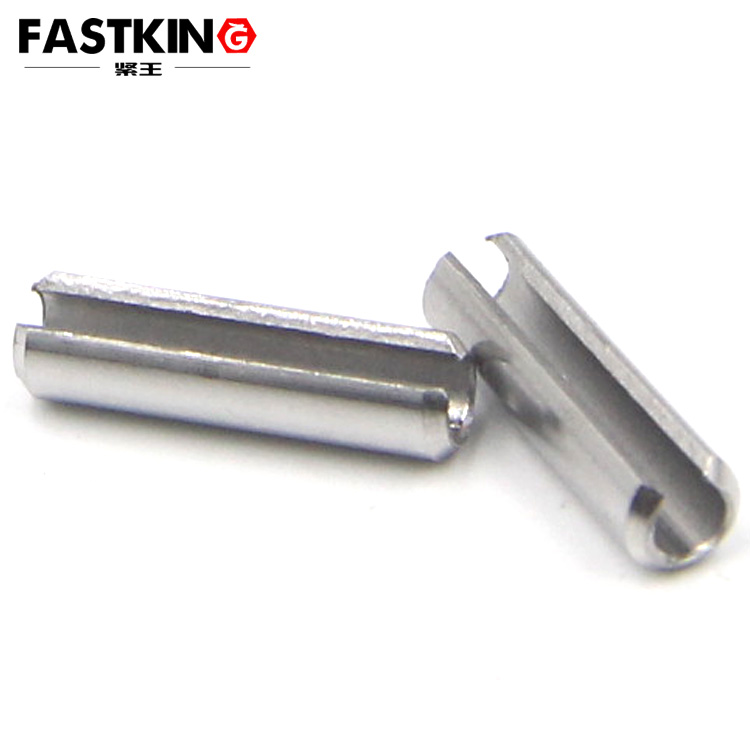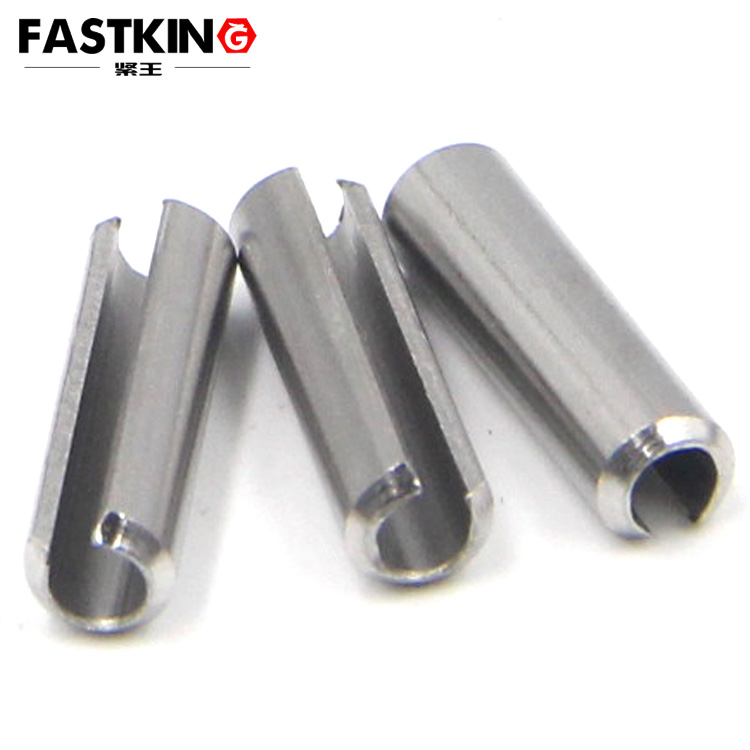Introduction
Elastic cylindrical pins, also known as spring pins or elastic pins, are widely used fasteners in mechanical assembly. They achieve the fixation and connection of parts through their own elastic deformation, offering advantages such as easy installation, convenient disassembly, and strong load-bearing capacity. This article will provide a detailed introduction to the application scenarios and usage methods of elastic cylindrical pins, helping readers better understand and apply this important mechanical component.
Structure and Characteristics of Elastic Cylindrical Pins
1.1 Structure
Elastic cylindrical pins are typically made of high-elasticity steel and are cylindrical in shape with a longitudinal slit in the middle. This slit design allows the pin to undergo elastic deformation under radial pressure, adapting to different bore sizes and assembly requirements.
1.2 Characteristics
Elastic Deformation: Elastic cylindrical pins can undergo elastic deformation during installation, adapting to different bore sizes and ensuring a tight fit.
High Load-Bearing Capacity: Due to the elasticity of the material and the rationality of the structure, elastic cylindrical pins can withstand significant radial and axial loads.
Easy Installation: Elastic cylindrical pins can be installed without additional tools; they simply need to be pressed into the hole.
Convenient Disassembly: When disassembly is required, elastic cylindrical pins can be easily removed with simple tools without damaging the parts.
Application Scenarios of Elastic Cylindrical Pins

2.1 Mechanical Assembly
In mechanical assembly, elastic cylindrical pins are commonly used to connect and fix two or more parts. For example, in the assembly of gears, shafts, and connecting rods, elastic cylindrical pins can effectively transmit torque and prevent relative movement.
2.2 Automotive Industry
In automotive manufacturing, elastic cylindrical pins are widely used in the connection and fixation of key components such as engines, transmissions, and chassis. Due to their high load-bearing capacity and reliability, elastic cylindrical pins play an important role in the automotive industry.
2.3 Electronic Devices
In the manufacturing of electronic devices, elastic cylindrical pins are often used to fix circuit boards, connectors, and other components. Their compact size and reliable performance make them indispensable fasteners in electronic devices.
2.4 Furniture Manufacturing
In furniture manufacturing, elastic cylindrical pins are commonly used to connect and fix various parts of furniture, such as table legs and crossbeams. Their easy installation and convenient disassembly make furniture assembly and maintenance more efficient.
2.5 Aerospace
In the aerospace field, elastic cylindrical pins are used to connect and fix various high-precision mechanical components. Due to their high reliability and fatigue resistance, elastic cylindrical pins are widely used in aerospace applications.
Usage Methods of Elastic Cylindrical Pins
3.1 Selecting the Appropriate Elastic Cylindrical Pin
Before using an elastic cylindrical pin, it is essential to select the appropriate pin based on assembly requirements. The following factors should be considered:
Bore Size: The diameter of the elastic cylindrical pin should be slightly larger than the bore diameter to ensure a tight fit.
Material: Choose the appropriate material based on the operating environment, such as stainless steel or carbon steel.
Length: The length of the elastic cylindrical pin should be selected based on the thickness of the assembly parts and the connection requirements.

3.2 Installing Elastic Cylindrical Pins
The steps for installing elastic cylindrical pins are as follows:
Clean the Hole and Pin: Before installation, ensure that the surfaces of the hole and the elastic cylindrical pin are clean, free of oil, and debris.
Align the Hole: Align the elastic cylindrical pin with the hole to be connected, ensuring that the pin and the hole's centerline are aligned.
Press the Pin: Use appropriate tools (such as a hammer or press) to press the elastic cylindrical pin into the hole. Apply force evenly during the pressing process to avoid deformation or damage to the pin.
Check the Installation: After installation, check whether the elastic cylindrical pin is securely fixed in the hole and ensure that the connected parts are not loose.
3.3 Disassembling Elastic Cylindrical Pins
When disassembling elastic cylindrical pins, follow these steps:
Select the Appropriate Tool: Use suitable tools (such as a pin puller or pliers) to grip the end of the elastic cylindrical pin.
Apply Pulling Force: Apply pulling force evenly to remove the elastic cylindrical pin from the hole. Avoid excessive force during the removal process to prevent damage to the pin or connected parts.
Inspect the Pin and Hole: After disassembly, inspect the condition of the elastic cylindrical pin and the hole to ensure there is no damage or deformation.
3.4 Maintenance and Care
To ensure the long-term performance of elastic cylindrical pins, proper maintenance and care are necessary:
Regular Inspection: Regularly inspect the connection status of elastic cylindrical pins to ensure there is no looseness or wear.
Cleaning and Maintenance: Clean the surfaces of the elastic cylindrical pin and the hole during disassembly and reinstallation to ensure they are free of debris and oil.
Replace Damaged Pins: If an elastic cylindrical pin is found to be deformed, worn, or damaged, it should be replaced promptly to ensure the reliability of the connection.
Precautions for Using Elastic Cylindrical Pins
4.1 Selecting the Appropriate Bore Size
The diameter of the elastic cylindrical pin should be slightly larger than the bore diameter to ensure a tight fit. If the bore is too large, the pin may not be securely fixed; if the bore is too small, the pin may not be installed smoothly.

4.2 Avoiding Excessive Force
When installing and disassembling elastic cylindrical pins, avoid applying excessive force to prevent deformation or damage to the pin. Applying force evenly ensures a smooth installation and disassembly process.
4.3 Considering the Operating Environment
The operating environment significantly affects the performance of elastic cylindrical pins. In high-temperature, high-humidity, or corrosive environments, choose materials that are resistant to high temperatures and corrosion to ensure the long-term performance of the pins.
4.4 Regular Inspection
Regularly inspect the connection status of elastic cylindrical pins to ensure there is no looseness or wear. Promptly identifying and addressing issues can prevent mechanical failures caused by pin failure.
Conclusion
As an important mechanical fastener, elastic cylindrical pins offer advantages such as easy installation, convenient disassembly, and strong load-bearing capacity. They are widely used in mechanical assembly, the automotive industry, electronic devices, furniture manufacturing, and aerospace. Proper selection and use of elastic cylindrical pins can ensure the reliability and stability of mechanical connections. Through this article, it is hoped that readers can better understand and apply elastic cylindrical pins, improving the efficiency and quality of mechanical assembly.
